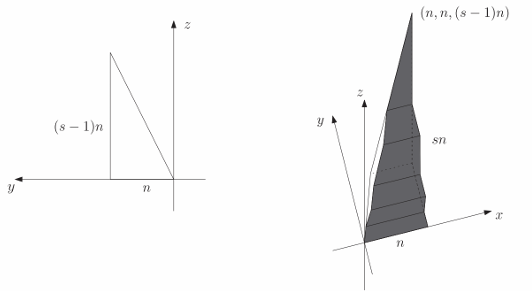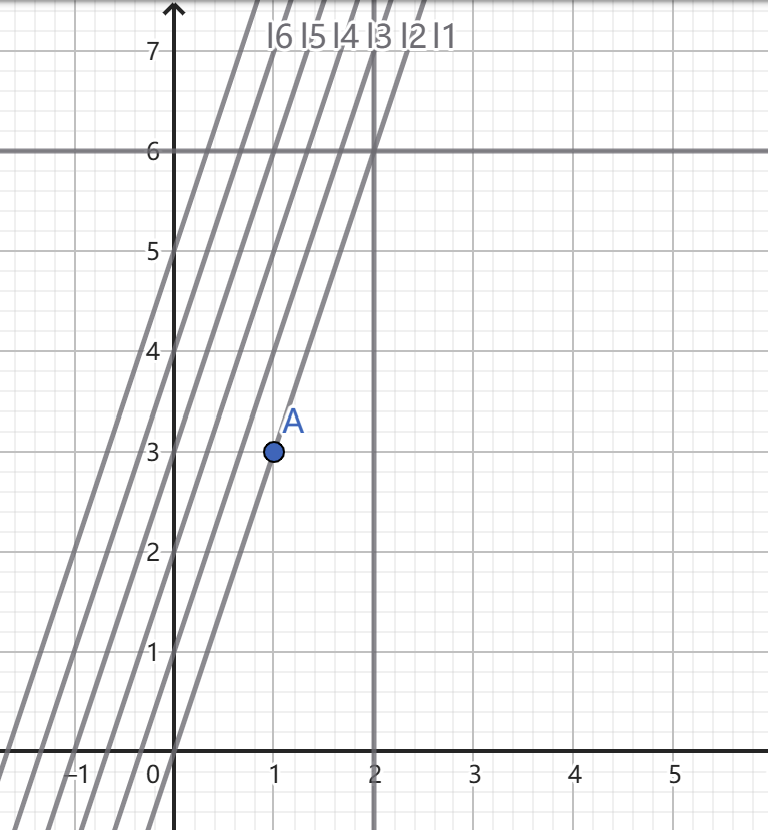1. Introduction
As an old special combination number, Catalan numbers are related to many kinds of combinatorial problems and other counting problems in mathematics. Its expression is as follows:
The most common Catalan numbers have many combinatorics interpretions like binary trees, triangulations, binary parenthesizations, plane trees, Dyck path, ballet sequence and so on. You can see more detailed applications in Stanley's lectures [1].
In 1915, MacMahen [2] firstly solved the n-ballot problem, and proposed the higher-dimension-Catalan numbers, and later in 1983, Zeilberger [3] solved this problem by a new algebraic combinatoarics way called the reflection principle. The expression they got is:
The reflection principle mainly uses some properties between the symmetric group and its action on the Dyck path. The main lemma he got was:
where
Also, some other generalizations of Catalan numbers were proposed like q-Calatan numbers, which was introduced by Fürlinger and Hofbauer [4], using the idea of q-analogue:
It can be related to some more complex Dyck path problem and other counting problems.
Fuss-Catalan numbers is another generalization, which was proposed by Fuss in 1791 and Raney [5] later(which is much earlier than the formally proposing of Catalan numbers), its expression is as follows:
This kind of generalization is also related to some more restricted Dyck path, specifically, it counts the number of ways from
2. The main results
We may review the detailed proof of Zeilberger, and try to propose a new proof of the formula for the higher-dimension-Catalan numbers, also, give two generalizations of Catatlan numbers.
2.1. Zeilberger's proof
Like the introduction says, Zeilberger's proof mainly use the idea of permutation groups' action on the path
We will call a path from
Let us consider doing something to all the bad ones. If some path touches the hyperplane in their walk to the final point
In order to get the reflection point of any point
Let
While for any
What we want to get is the number of
The final step to calculate the determinant is a interesting exercise like the VanderMonde determinant.
2.2. Our new combinatorics proof
Definition: ordered Catalan numbers
Consider a sequence with
rule2.2.1.
We denote the numbers of elements in the first k elements from
rule2.2.2.
For the
Lemma2.1.
The ordered Catalan numbers satisfy that:
Proof.For the d-dimensional Catalan numbers, it only needs to satisfy rule one and that the group
Let us calculate the
We claim that
lemma2.2.
Let's consider all of the permutations of
proof.
Let us prove it by gap filling method. Firstly, we denote the elements from group
Let's return to the original problem. Because the elements in the
And then we suppose that
Because the sequence
Now let us consider the elements of the first elements of the first
Therefore,
Then, because we have
2.3. Combination of two kinds of Catalan numbers
What we try to do in this section is to combine the Fuss-Catalan numbers and higher-dimension Catalan numbers. The Fuss-Catalan number has the form:
This number can be interpreted as: the path from
it can be seen that the path from
The following is a visual picture about the above proof of the three-dimensional restricted Fuss-Catalan numbers:

We may naturally consider the high-dimensional cases as the three-dimensional one. We will first consider the four-dimensional case for simplicity.
Consider the path from
We may just project the
Therefore, for d-dimensional case,
the number is just
Besides, we are also interested in the ratio between higher-dimension Catalan numbers and the above higher-Fuss-Catalan numbers.
And for simplicity, we firstly see the
=
=
It's clear that as
2.4. A generalization for the coefficient of Fuss-Catalan numbers
For the Fuss-Catalan numbers, we consider the condition that
Firstly, let us consider a variant type of the counting problem for Fuss-Catalan numbers: we can consider the paths on a Cartesian plane, start from the point
Rule2.4.1.
We can only move one unit of distance in the
Rule2.4.2.
All of the paths shouldn't go above the line that passes through the point (0,0) with slope
According to the definition that
We claim that, for
We can notice that the numbers of the qualified paths only depend on the integer point under the restriction line, the numbers of the paths changes if and only if the change of restriction line adds or mines the integer point, so we are interested in the coordinate of the first added integer point as the slope of the restriction line increases. We claim that the coordinate of the first added point is
For the proof, we consider drawing all the lines with the same slope as

It is clear that there are no integer points between adjoint two lines, so for all the integer points beyond the
Therefore, we get the equality:
And now we may consider the case if
We can divide the path into two sorts: one goes through the point
This way, we have generalized the coefficient of the Fuss-Catalan numbers into a real numbers interval. Using the same method, if we can find the next added integer point, then we can generalize the coefficient into all of the positive real numbers.
3. Some corollaries and combinatorics
Catalan numbers have been shown to have a link with binary trees. We are now interested in the m-ary trees and some counting problems' bijection in m-analogue cases.
3.1. M-ary trees
The binary trees problem can be described as follows: How many different configurations are there for a binary tree with n nodes where each non-leaf node has exactly two children? The m-ary tree is similar to it.
We will finally find that the number of m-ary trees with n-node is just the Fuss-Catalan number:
Lemma 3.1
If
have all partial sums positive.
We may denote the
while the
Now consider the set
On the other hand, we claim that
where
Suppose that
belongs to some
so
Conversely, if
Now the equation 3.2 and equation 3.4 are the same recurrence relation, and
which are exactly the fuss-catalan numbers.
3.2. Bijections between counting problems
Like the original catalan numbers, fuss-catalan number can discribe a lot of combinatorics counting problems.
For example, like the generalized dyck path and m-ary trees, these two counting problems obviously get the same number,
3.3. Division problem
Catalan numbers count the number of ways to divide an
Lemma 3.2
Dividing
proof
We may use the mathematical induction.
Let
Assume the statement holds for some arbitrary
We will now prove that if the statement holds for
Consider a newly-added vertex
The
It's worth mentioning that internal edge changes from
Then we will prove the recursion relationship
By the principle of mathematical induction, we have shown that the statement holds for all
Therefore, the lemma is proved.
From another perspective, the division problem is also the Fuss-Catalan number:
To divide an
Since one
We may denote the
while the
Acknowledgments
Ziqiao Xu, Zhanbo Liu, and Ziqian Wang contributed equally to this work and should be considered co-first authors. Also, we are sincerely grateful to Professor Dan Ciubotaru and NEOSHCOOL's teachers.
References
[1]. Richard P. Stanley. Catalannumbers. MITlecturenotes.Availableat https: //math.mit.edu/~rstan/transparencies/china.pdf.
[2]. P. A. MacMahon. Combinatory Analysis, volume I. Cambridge University Press, 1915-1916.
[3]. Doron Zeilberger. Andre’s reflection proof generalized to the many-candidate ballot problem. Discrete Mathematics, 44: 325–326, 1983.
[4]. FüRLINGER and J.HOFBAUER. Q-catalan numbers. JOURNAL OF COMBINATORIAL THEORY, Series A: 248–264, 1985.
[5]. G.N.Raney. Functional composition patterns and power series reversion. Trans.Amer.Math.Soc., 94(2): 441–451, 1960.
[6]. JINHONG-LIN. Yibanxing catalan shu de zuhe yiyi jiqi zuoyong. SHUXUECHUANBO, 35.1: 36–50, 2011.
[7]. Brian M. Scott. able at number of ternary trees: finding a recurrent relationship. mathstackexchange Avail https: //math.stackexchange.com/questions/1596453/ number-of-ternary-trees-finding-a-recurrent-relationship
Cite this article
Xu,Z.;Liu,Z.;Wang,Z. (2025). Generalizations of Catalan Numbers and Combinatorics. Applied and Computational Engineering,174,242-253.
Data availability
The datasets used and/or analyzed during the current study will be available from the authors upon reasonable request.
Disclaimer/Publisher's Note
The statements, opinions and data contained in all publications are solely those of the individual author(s) and contributor(s) and not of EWA Publishing and/or the editor(s). EWA Publishing and/or the editor(s) disclaim responsibility for any injury to people or property resulting from any ideas, methods, instructions or products referred to in the content.
About volume
Volume title: Proceedings of CONF-CDS 2025 Symposium: Data Visualization Methods for Evaluatio
© 2024 by the author(s). Licensee EWA Publishing, Oxford, UK. This article is an open access article distributed under the terms and
conditions of the Creative Commons Attribution (CC BY) license. Authors who
publish this series agree to the following terms:
1. Authors retain copyright and grant the series right of first publication with the work simultaneously licensed under a Creative Commons
Attribution License that allows others to share the work with an acknowledgment of the work's authorship and initial publication in this
series.
2. Authors are able to enter into separate, additional contractual arrangements for the non-exclusive distribution of the series's published
version of the work (e.g., post it to an institutional repository or publish it in a book), with an acknowledgment of its initial
publication in this series.
3. Authors are permitted and encouraged to post their work online (e.g., in institutional repositories or on their website) prior to and
during the submission process, as it can lead to productive exchanges, as well as earlier and greater citation of published work (See
Open access policy for details).
References
[1]. Richard P. Stanley. Catalannumbers. MITlecturenotes.Availableat https: //math.mit.edu/~rstan/transparencies/china.pdf.
[2]. P. A. MacMahon. Combinatory Analysis, volume I. Cambridge University Press, 1915-1916.
[3]. Doron Zeilberger. Andre’s reflection proof generalized to the many-candidate ballot problem. Discrete Mathematics, 44: 325–326, 1983.
[4]. FüRLINGER and J.HOFBAUER. Q-catalan numbers. JOURNAL OF COMBINATORIAL THEORY, Series A: 248–264, 1985.
[5]. G.N.Raney. Functional composition patterns and power series reversion. Trans.Amer.Math.Soc., 94(2): 441–451, 1960.
[6]. JINHONG-LIN. Yibanxing catalan shu de zuhe yiyi jiqi zuoyong. SHUXUECHUANBO, 35.1: 36–50, 2011.
[7]. Brian M. Scott. able at number of ternary trees: finding a recurrent relationship. mathstackexchange Avail https: //math.stackexchange.com/questions/1596453/ number-of-ternary-trees-finding-a-recurrent-relationship









